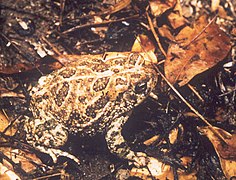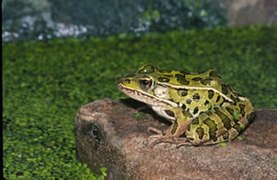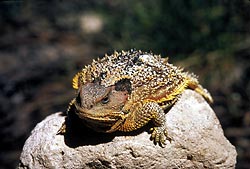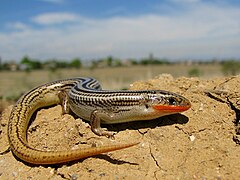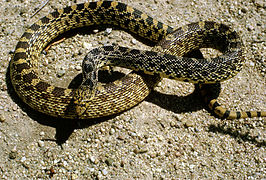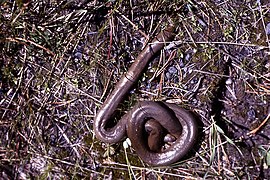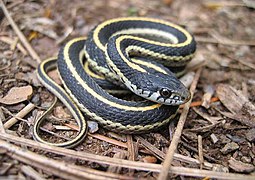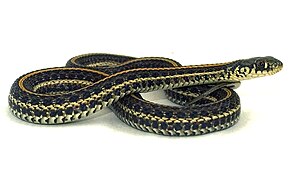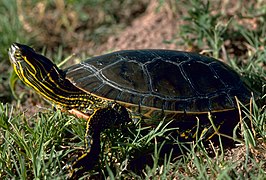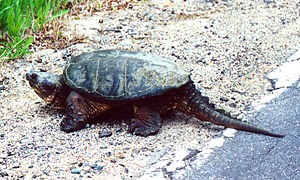Amphibians and reptiles of Wyoming

Amphibians
-
Tiger salamander
-
Boreal chorus frog
-
Plains spadefoot toad
-
Wyoming toad
-
Woodhouse's toad
-
Western toad
-
Great Plains toad
-
Columbia Spotted frog
-
Northern Leopard frog
-
American bullfrog
Tiger salamander
The
In Wyoming, the salamander is found in most habitat types with a body of nonflowing water nearby for breeding.[2]
Boreal chorus frog
The
In Wyoming, this frog is found in marshes, ponds, small lakes, up to 12,000 feet (3,700 m).[3]
Great Basin spadefoot toad
The
In Wyoming, this toad is found in sagebrush communities below 6,000 feet (1,800 m), west of the Continental Divide.[4]
Plains spadefoot toad
The
In Wyoming, this toad is found in grasslands and sagebrush communities below 6,000 feet (1,800 m) east of the Continental Divide.[5]
Western toad
The western toad or boreal toad (Bufo boreas) is a large toad species, between 5.6 and 13 cm long, of western North America. It has a white or cream dorsal stripe, and is dusky gray or greenish dorsally with skin glands concentrated within the dark blotches.
In Wyoming, this toad occurs in wet areas in foothills, montane, and subalpine zones from 8,000 to 11,000 feet (2,400 to 3,400 m).[6]
Woodhouse's toad
In Wyoming, this toad is found in floodplains containing permanent water or irrigation runoff in the plains and foothills east of the Continental Divide below 6,000 feet (1,800 m).[8]
Great Plains toad
The Great Plains toad (Bufo cognatus) is a relatively large species of toad. It ranges from southern Alberta, throughout the western United States, and into northern Mexico. The toad is grey, brown, and green in color, with darker colored blotching. It can grow to anywhere between 2 and 4.5 inches (5.1 and 11.4 cm) in length. Its primary diet is various species of cutworms. It prefers grassland habitat with loose soil that is easy to burrow in. Breeding occurs throughout the spring and summer months, most often immediately after heavy rainfall. In dry areas it may only emerge from its burrow for a few weeks when conditions are right, and only at night, but in areas with permanent water bodies and abundant rain it may be active all day.[9] It has a very loud, harsh mating call.
In Wyoming, this toad is found in plains grasslands, sandhills, agricultural areas, below 6,000 feet (1,800 m).[10]
Wyoming toad
The Wyoming toad or Baxter's toad (Bufo baxteri or Anaxyrus baxteri) is an extremely rare amphibian that exists only in captivity and within Mortenson Lake National Wildlife Refuge in the U.S. state of Wyoming. The Wyoming toad was listed as an endangered species in 1984, and listed as extinct in the wild since 1991. Before the sharp declines occurred, this toad was classified as a subspecies of the Canadian toad.[11]
American bullfrog
The
In Wyoming, this frog is found near permanent water below 6,000 feet (1,800 m) on the eastern plains.[17]
Columbia spotted frog
The Columbia spotted frog (Rana luteiventris) is a North American species of frog. It is a medium-sized frog reaching lengths of up to three and a half inches (8.9 cm). Its color ranges from a dark, olive green to light brown with irregularly-shaped black spots on its back and legs (rendering its name). The belly and upper lip are white in color. Individuals can be distinguished from other Rana species by their shorter back legs, narrow snout and upturned eyes. Since they spend most of their time in the water, they also have more webbing in their hind feet than similar species.
In Wyoming this frog is found in ponds, sloughs, and small streams in the foothills and montane zones.[18]
Northern leopard frog
The
In Wyoming, this frog is found in swampy cattail marshes and beaver ponds in the plains, foothills, and montane zones up to 9,000 feet (2,700 m).[20]
Wood frog
The
In Wyoming, this frog is found in beaver ponds, small lakes, slow moving streams, wet meadows, willow thickets, in the montane zone usually at or near 9,000 feet (2,700 m).[21]
Reptiles
-
Sagebrush lizard
-
Short-horned lizard
-
Prairie racerunner
-
Many-lined skink
-
Ornate tree lizard
-
Earless lizard
-
Gopher snake
-
Milksnake
-
Eastern racer
-
Prairie rattlesnake
-
Rubber boa
-
Common garter snake
-
Terrestrial garter snake
-
Plains garter snake
-
Smooth greensnake
-
Western hog-nosed snake
-
Western painted turtle
-
Snapping turtle
-
Spiny softshell
-
Ornate box turtle
Prairie racerunner
The six-lined racerunner (Cnemidophorus sexlineatus) is a species of lizard found in the United States, from Wyoming across the Great Plains east to Rhode Island, south to Florida and west to southern Texas, and in northern Mexico, in Tamaulipas.
In Wyoming, the sub-species C. s. viridis is found in plains grasslands, sandhills, sandy or gravelly streambanks, and stream floodplains.[22]
Common sagebrush lizard
The
In Wyoming, the lizard is found in rock outcrops in sagebrush, juniper, semi-arid shrublands, and mountain foothills shrublands, usually below 6,000 feet (1,800 m). It occurs in association with geothermal features in Yellowstone National Park at 7,500 feet (2,300 m).[23]
Mountain short-horned lizard
The
In Wyoming, this lizard is found in grasslands, sagebrush-grasslands.[24]
Eastern fence lizard
The eastern fence lizard (Sceloporus undulatus) is a medium-sized species of lizard found along forest edges, rock piles, and rotting logs or stumps in the eastern United States. It is sometimes referred to as the prairie lizard, fence swift, or gray lizard.
In Wyoming, the sub-species S. u. elongatus, the northern plateau lizard is found in rock outcrops and canyon walls in sagebrush communities. The sub-species S. u. erythrocheilus, the Red-lipped Plateau lizard is restricted to rock cliffs and large areas of boulders along the hogback on the east edge of the
Many-lined skink
The
In Wyoming, this lizard is found in grassland communities on the prairies and in scarp woodlands. It usually occurs under surface objects such as flat rocks or boards.[26]
Cliff tree lizard
The tree lizard or ornate tree lizard (Urosaurus ornatus) is a species of lizard that is native to the southwestern United States and northern Mexico. The species has been used to research the physiological changes in the body during the fight-or-flight response as related to stress and aggressive competition.[27]
In Wyoming, the sub-species U. o. wrighti is found in cliffs and rocky canyon slopes in sagebrush desert communities.[28]
Great Plains earless lizard
The lesser earless lizard (Holbrookia maculata) is a species of phrynosomid lizard endemic to the southwestern and central United States and northern Mexico. It is found in the states of Arizona, New Mexico, Texas, Utah, Colorado, Kansas, Oklahoma, Nebraska, South Dakota and Wyoming, as well as in the Mexican states of Sonora, Chihuahua, Coahuila, Sinaloa, Durango, Zacatecas, San Luis Potosí and Nuevo León.
In Wyoming, the sub-species H. m. maculata is found in plains grassland communities with yucca and exposed sandy areas.[29]
Gophersnake
The gophersnake or
In Wyoming, the bullsnake is found in plains grasslands, sagebrush grasslands, sandhills, riparian shrub, marshes, rocky canyons, mountain foothills shrub, agricultural areas, and urban areas. The sub-species Pituophis catenifer deserticola, the Great Basin Gophersnake is found in sagebrush communities and desert habitats.[30]
Milk snake
The milk snake (Lampropeltis triangulum) is a species of king snake. There are 25 subspecies among the milk snakes, including the commonly named scarlet kingsnake (L. t. elapsoides).[31] The subspecies have strikingly different appearance, and many of them have their own common names.[31] They are distributed from southeastern Canada, through most of the continental United States, to Central America, down to western Ecuador and northern Venezuela of northern South America.[31][32] They grow 20 to 60 inches (51 to 152 cm) long.[31]
In Wyoming, the sub-species L. t. multistriata, the pale milksnake is found in grasslands, sandhills, and scarp woodlands, usually below 6,000 feet (1,800 m).[33]
Prairie rattlesnake
The
In Wyoming, this snake is found in plains, foothills, and scarp woodlands, especially near granite or limestone outcrops. The sub-species Crotalus viridis concolor, the midget faded rattlesnake is found in rock outcrops in sagebrush desert communities. Its range is restricted to the lower Green River Valley from the cities of Green River and Rock Springs south to the Utah-Wyoming state line.[34]
Rubber boa
The rubber boa (Charina bottae) is a snake in the family Boidae and genus Charina. Boidae consists of the nonvenomous snakes commonly called boas and consists of 43 species. The genus Charina consists of four species, three of which are found in North America, and one species found in Africa.
In Wyoming, this boa is found in near water and beneath logs, flat rocks, and other surface objects in the foothills and lower montane zones.[35]
Plains garter snake
The plains garter snake (Thamnophis radix) is a species of garter snake native to most of the Central United States stretching as far north as Canada and as far south as Texas. It has a distinctive orange or yellow stripe that goes from its head to tail, the rest of its body is mainly a gray-green color. The snake is commonly found living near water sources such as streams and ponds, but can also be found in urban areas and vacant lots.
In Wyoming, this snake is found near small streams, sloughs, marshes, and ponds. May be found in urban areas, dry grasslands, sandhills.[36]
Common garter snake
The
In Wyoming, this snake is found in plains, foothills, montane zones, and usually near permanent water sources. The sub-species T. s.parietalis, the Red-sided Gartersnake is found near marshes, ponds, and small streams.[37]
Terrestrial garter snake
The wandering garter snake (Thamnophis elegans vagrans) is a subspecies of the western terrestrial garter snake, a species of colubrid snake residing only in southwestern Canada, and the western United States. Seven subspecies are currently recognized. Most snakes have a yellow, light orange, or white dorsal stripe, accompanied by two stripes on its side of the same color. Some varieties have red or black spots between the dorsal stripe and the side stripes. This snake often inhabits coniferous forests, and is relatively aquatic.
In Wyoming, this snake is found in all habitat zones except alpine, usually near water.[38]
Eastern racer
The
In Wyoming, the sub-species C. c. flaviventris is found woodlands and scarp woodlands within the plains and foothills zones, often near water.[39]
Smooth greensnake
The
In Wyoming, this snake is found under rocks, logs, or other surface objects in forests within the foothills and montane zones. Usually associated with lush vegetation.[40]
Black Hills red-bellied snake
The red-bellied snake (Storeria occipitomaculata occipitomaculata) is very small brown or gray snake with faint stripes down its back. The belly is red, pink, or orange. Adult length is 8 to 16 inches. Red-bellied snakes inhabit both fields and woods, but are most often found under boards and other objects at the edges of lumber piles or trash dumps. They feed on worms, slugs, and snails.
In Wyoming, the sub-species S. o. pahasapae is found near water under flat rocks, logs, and other surface objects in moist woodland communities.[41]
Western hog-nosed snake
The
In Wyoming, the plains hog-nosed snake, H. n. nasicus is found in burrows in soft soil or sand in plains grasslands and sandhills.[42]
Snapping turtle
The
In Wyoming, this turtle is found in permanent lakes, ponds, and large streams, below 6,000 feet (1,800 m).[43]
Spiny softshell
The
In Wyoming, the sub-species A. s. hartwegi is found in permanent lakes, ponds, large streams, below 6,000 feet (1,800 m).[44]
Ornate box turtle
The ornate box turtle (Terrapene ornata ornata) is one of only two terrestrial species of turtles native to the Great Plains of the United States. It is one of the two different subspecies of Terrapene ornata. It is the state reptile of Kansas.[45] It is a relatively small turtle, that is currently not endangered or threatened but is of concern and protected in six Midwestern states (Colorado, Iowa, Indiana, Nebraska, Kansas, and Wisconsin).[46]
In Wyoming, this turtle is found in grasslands and sandhills in Goshen County.[47]
Western painted turtle
The painted turtle (Chrysemys picta) is the most widespread native turtle of North America. It lives in slow-moving fresh waters, from southern Canada to Louisiana and northern Mexico, and from the Atlantic to the Pacific. The turtle is the only species of the genus Chrysemys, which is part of the pond turtle family, Emydidae.
In Wyoming, the sub-species C. p. bellii is found in permanent ponds, reservoirs, marshes, and slow moving streams, below 6,000 feet (1,800 m).[48]
See also
- Birds of Wyoming
- Mammals of Wyoming
Further reading
- Baxter, G. T. & M. D. Stone (1980). "Amphibians and Reptiles of Wyoming". Wyoming Game and Fish Department Bulletin (16).
- Koch, E. D.; C. R. Peterson (1995). Amphibians and Reptiles of Yellowstone and Grand Teton National Parks. Salt Lake City, Utah: University of Utah Press. ISBN 9780874804720.
- Stebbins, Robert C. (1954). Amphibians and Reptiles of Western North America. New York: McGraw-Hill Book Company.
Notes
- ^ Cerovski, A.O.; M. Grenier; B. Oakleaf; L. Van Fleet; S. Patla (2004). Atlas of Birds, Mammals, Amphibians, and Reptiles in Wyoming (PDF). Lander, WY: Wyoming Game and Fish Department Nongame Program. pp. 155–164.
- ^ "Atlas of Birds, Mammals, Amphibians, and Reptiles in Wyoming-Tiger salamander" (PDF). Wyoming Game and Fish Department, Wildlife Division. p. 155. Retrieved 2011-12-29.
- ^ "Atlas of Birds, Mammals, Amphibians, and Reptiles in Wyoming-Boreal chorus frog" (PDF). Wyoming Game and Fish Department, Wildlife Division. p. 157. Retrieved 2011-12-29.
- ^ "Atlas of Birds, Mammals, Amphibians, and Reptiles in Wyoming-Great Basin spadefoot" (PDF). Wyoming Game and Fish Department, Wildlife Division. July 2004. p. 155. Retrieved 2011-12-29.
- ^ "Atlas of Birds, Mammals, Amphibians, and Reptiles in Wyoming-Plains spadefoot" (PDF). Wyoming Game and Fish Department, Wildlife Division. July 2004. p. 155. Retrieved 2011-12-29.
- ^ "Atlas of Birds, Mammals, Amphibians, and Reptiles in Wyoming-Western toad" (PDF). Wyoming Game and Fish Department, Wildlife Division. July 2004. p. 155. Retrieved 2011-12-29.
- ^ "Biographies of People Honored in the Names of the Reptiles and Amphibians of North America".
- ^ "Atlas of Birds, Mammals, Amphibians, and Reptiles in Wyoming-Woodhouse's toad" (PDF). Wyoming Game and Fish Department, Wildlife Division. July 2004. p. 156. Retrieved 2011-12-29.
- ^ Grismer, L. L. (2002). Amphibians and Reptiles of Baja California. Los Angeles: University of California Press, 69.
- ^ "Atlas of Birds, Mammals, Amphibians, and Reptiles in Wyoming-Great Plains toad" (PDF). Wyoming Game and Fish Department, Wildlife Division. July 2004. p. 156. Retrieved 2011-12-29.
- . Retrieved 9 January 2018. Database entry includes a range map and a brief justification of why this species is listed as extinct in the wild.
- ^ a b c Hillis, D. M. 2007. Constraints in naming parts of the Tree of Life. Molecular Phylogenetics and Evolution 42:331–338.
- ^ a b c Hillis, D. M., and T. P. Wilcox. 2005. Phylogeny of the New World True frogs (Rana. Molecular Phylogenetics and Evolution 34:299–314.
- ^ "Rana catesbeiana". Integrated Taxonomic Information System. Retrieved 6 February 2006.
- ^ Hillis & Wilcox (2005), Pauly et al. (2009)
- ^ Conant, 1958
- ^ "Atlas of Birds, Mammals, Amphibians, and Reptiles in Wyoming-American bullfrog" (PDF). Wyoming Game and Fish Department, Wildlife Division. July 2004. p. 156. Retrieved 2011-12-29.
- ^ "Atlas of Birds, Mammals, Amphibians, and Reptiles in Wyoming-Columbia Spotted frog" (PDF). Wyoming Game and Fish Department, Wildlife Division. July 2004. p. 157. Retrieved 2011-12-29.
- ^ a b Pauly et al. (2009)
- ^ "Atlas of Birds, Mammals, Amphibians, and Reptiles in Wyoming-Northern Leopard frog" (PDF). Wyoming Game and Fish Department, Wildlife Division. July 2004. p. 157. Retrieved 2011-12-29.
- ^ "Atlas of Birds, Mammals, Amphibians, and Reptiles in Wyoming-Wood frog" (PDF). Wyoming Game and Fish Department, Wildlife Division. July 2004. p. 157. Retrieved 2011-12-29.
- ^ "Atlas of Birds, Mammals, Amphibians, and Reptiles in Wyoming-Prairie Racerunner" (PDF). Wyoming Game and Fish Department, Wildlife Division. July 2004. p. 159. Retrieved 2011-12-29.
- ^ "Atlas of Birds, Mammals, Amphibians, and Reptiles in Wyoming-Common Sagebrush lizard" (PDF). Wyoming Game and Fish Department, Wildlife Division. July 2004. p. 159. Retrieved 2011-12-29.
- ^ "Atlas of Birds, Mammals, Amphibians, and Reptiles in Wyoming-Short-horned lizard" (PDF). Wyoming Game and Fish Department, Wildlife Division. July 2004. p. 160. Retrieved 2011-12-29.
- ^ "Atlas of Birds, Mammals, Amphibians, and Reptiles in Wyoming-Eastern Fence lizard" (PDF). Wyoming Game and Fish Department, Wildlife Division. July 2004. pp. 159–160. Retrieved 2011-12-29.
- ^ "Atlas of Birds, Mammals, Amphibians, and Reptiles in Wyoming-Many-lined skink" (PDF). Wyoming Game and Fish Department, Wildlife Division. July 2004. p. 159. Retrieved 2011-12-29.
- S2CID 40870214.
- ^ "Atlas of Birds, Mammals, Amphibians, and Reptiles in Wyoming-Clif Tree lizard" (PDF). Wyoming Game and Fish Department, Wildlife Division. July 2004. p. 160. Retrieved 2011-12-29.
- ^ "Atlas of Birds, Mammals, Amphibians, and Reptiles in Wyoming-Earless lizard" (PDF). Wyoming Game and Fish Department, Wildlife Division. July 2004. p. 161. Retrieved 2011-12-29.
- ^ "Atlas of Birds, Mammals, Amphibians, and Reptiles in Wyoming-bullsnake" (PDF). Wyoming Game and Fish Department, Wildlife Division. July 2004. pp. 162–163. Retrieved 2011-12-29.
- ^ a b c d Hutchins, Michael; Evans, Arthur V.; Jackson, Jerome A.; et al., eds. (2004), Grzimek's Animal Life Encyclopedia, vol. 7: Reptiles (2nd ed.), Detroit: Gale, p. 477
- JSTOR 1565915
- ^ "Atlas of Birds, Mammals, Amphibians, and Reptiles in Wyoming-Milksnake" (PDF). Wyoming Game and Fish Department, Wildlife Division. July 2004. p. 162. Retrieved 2011-12-29.
- ^ "Atlas of Birds, Mammals, Amphibians, and Reptiles in Wyoming-Prairie Rattlesnake" (PDF). Wyoming Game and Fish Department, Wildlife Division. July 2004. p. 164. Retrieved 2011-12-29.
- ^ "Atlas of Birds, Mammals, Amphibians, and Reptiles in Wyoming-Rubber Boa" (PDF). Wyoming Game and Fish Department, Wildlife Division. July 2004. p. 161. Retrieved 2011-12-29.
- ^ "Atlas of Birds, Mammals, Amphibians, and Reptiles in Wyoming-Plains Garter snake" (PDF). Wyoming Game and Fish Department, Wildlife Division. July 2004. p. 164. Retrieved 2011-12-29.
- ^ "Atlas of Birds, Mammals, Amphibians, and Reptiles in Wyoming-Common Garter snake" (PDF). Wyoming Game and Fish Department, Wildlife Division. July 2004. p. 163. Retrieved 2011-12-29.
- ^ "Atlas of Birds, Mammals, Amphibians, and Reptiles in Wyoming-Western Terrestrial Garter snake" (PDF). Wyoming Game and Fish Department, Wildlife Division. July 2004. p. 163. Retrieved 2011-12-29.
- ^ "Atlas of Birds, Mammals, Amphibians, and Reptiles in Wyoming-Eastern Racer" (PDF). Wyoming Game and Fish Department, Wildlife Division. July 2004. p. 161. Retrieved 2011-12-29.
- ^ "Atlas of Birds, Mammals, Amphibians, and Reptiles in Wyoming-Smooth Green snake" (PDF). Wyoming Game and Fish Department, Wildlife Division. July 2004. p. 162. Retrieved 2011-12-29.
- ^ "Atlas of Birds, Mammals, Amphibians, and Reptiles in Wyoming-Red-bellied snake" (PDF). Wyoming Game and Fish Department, Wildlife Division. July 2004. p. 162. Retrieved 2011-12-29.
- ^ "Atlas of Birds, Mammals, Amphibians, and Reptiles in Wyoming-Plains Hog-nosed snake" (PDF). Wyoming Game and Fish Department, Wildlife Division. July 2004. p. 161. Retrieved 2011-12-29.
- ^ "Atlas of Birds, Mammals, Amphibians, and Reptiles in Wyoming-Snapping turtle" (PDF). Wyoming Game and Fish Department, Wildlife Division. July 2004. p. 158. Retrieved 2011-12-29.
- ^ "Atlas of Birds, Mammals, Amphibians, and Reptiles in Wyoming-Spiny softshell turtle" (PDF). Wyoming Game and Fish Department, Wildlife Division. July 2004. p. 158. Retrieved 2011-12-29.
- ^ "Kansas State Animal". Archived from the original on 2011-02-05. Retrieved 2011-12-30.
- ^ Redder, AJ, CK Dodd, D Keinath, D Mcdonald and T Ise, 2006. "Ornate box turtle (Terrapene ornata ornata): A technical conservation assessment". USDA Forest Service, Rocky Mountain Region. Accessed November 29, 2008. Peer review administered by the Society for Conservation Biology
- ^ "Atlas of Birds, Mammals, Amphibians, and Reptiles in Wyoming-Ornate Box turtle" (PDF). Wyoming Game and Fish Department, Wildlife Division. July 2004. p. 158. Retrieved 2011-12-29.
- ^ "Atlas of Birds, Mammals, Amphibians, and Reptiles in Wyoming-Painted turtle" (PDF). Wyoming Game and Fish Department, Wildlife Division. July 2004. p. 158. Retrieved 2011-12-29.







